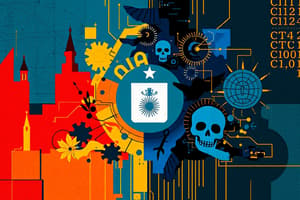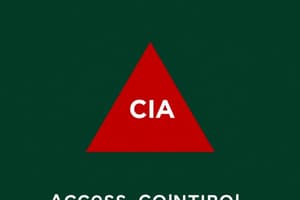Podcast
Questions and Answers
What does the CIA Triangle stand for in cyber security?
What does the CIA Triangle stand for in cyber security?
- Control, Integrity, Access
- Confidentiality, Integrity, Availability (correct)
- Communication, Integrity, Availability
- Confidentiality, Identity, Access
Cyber security only involves protecting digital systems and does not include human beings.
Cyber security only involves protecting digital systems and does not include human beings.
False (B)
Name one type of security threat that involves unauthorized access to information.
Name one type of security threat that involves unauthorized access to information.
Disclosure
Keeping data secret is referred to as __________ in the CIA Triangle.
Keeping data secret is referred to as __________ in the CIA Triangle.
Match the following security threats with their descriptions:
Match the following security threats with their descriptions:
What is the primary purpose of a security policy?
What is the primary purpose of a security policy?
Role-Based Access Control (RBAC) assigns permissions based only on job roles.
Role-Based Access Control (RBAC) assigns permissions based only on job roles.
What are the three components of the Identification, Authentication, and Authorisation process?
What are the three components of the Identification, Authentication, and Authorisation process?
In access control, the term 'DAC' stands for ______.
In access control, the term 'DAC' stands for ______.
Which type of access control is typically found in high-security systems?
Which type of access control is typically found in high-security systems?
Match the type of access control with its description:
Match the type of access control with its description:
Authentication creep occurs when old privileges are not revoked after an employee changes departments.
Authentication creep occurs when old privileges are not revoked after an employee changes departments.
What is one of the main purposes of digital signatures?
What is one of the main purposes of digital signatures?
Identification is not necessary in the process of authentication.
Identification is not necessary in the process of authentication.
What are the three types of authentication?
What are the three types of authentication?
A ___ key is used in encryption to secure the digital signature.
A ___ key is used in encryption to secure the digital signature.
How does requiring two modes of authentication impact safety?
How does requiring two modes of authentication impact safety?
Match the following terms with their definitions:
Match the following terms with their definitions:
A digital signature guarantees the signer can deny the validity of the document.
A digital signature guarantees the signer can deny the validity of the document.
What is the role of a public key in the context of digital signatures?
What is the role of a public key in the context of digital signatures?
The authentication process checks the user's details against a user ___ database.
The authentication process checks the user's details against a user ___ database.
Match the types of authentication with their examples:
Match the types of authentication with their examples:
What does 2 Factor Authentication (2FA) typically involve?
What does 2 Factor Authentication (2FA) typically involve?
Asymmetric encryption uses the same key for both encryption and decryption.
Asymmetric encryption uses the same key for both encryption and decryption.
What is the primary purpose of cryptography?
What is the primary purpose of cryptography?
A ______________ is a malicious piece of code that can replicate itself.
A ______________ is a malicious piece of code that can replicate itself.
Match the types of malware with their descriptions:
Match the types of malware with their descriptions:
Which of the following is NOT a type of malware?
Which of the following is NOT a type of malware?
Malware can be used for non-destructive purposes, such as adware.
Malware can be used for non-destructive purposes, such as adware.
What is a key requirement for encryption?
What is a key requirement for encryption?
__________ is designed to block access to a system until a ransom is paid.
__________ is designed to block access to a system until a ransom is paid.
Flashcards
Confidentiality
Confidentiality
The secrecy of data, preventing unauthorised access to information.
Integrity
Integrity
The integrity of data ensures information remains unchanged and accurate. This prevents tampering or modification.
Availability
Availability
Availability means making sure systems and data are accessible to authorised users when required.
Disclosure
Disclosure
Signup and view all the flashcards
Deception
Deception
Signup and view all the flashcards
Four Areas of Security
Four Areas of Security
Signup and view all the flashcards
Security Policy
Security Policy
Signup and view all the flashcards
Access Control
Access Control
Signup and view all the flashcards
Hierarchical Access Control
Hierarchical Access Control
Signup and view all the flashcards
Compartmental Access Control
Compartmental Access Control
Signup and view all the flashcards
Discretionary Access Control (DAC)
Discretionary Access Control (DAC)
Signup and view all the flashcards
Role-Based Access Control (RBAC)
Role-Based Access Control (RBAC)
Signup and view all the flashcards
What is cryptography?
What is cryptography?
Signup and view all the flashcards
What is plain text?
What is plain text?
Signup and view all the flashcards
What is cipher text?
What is cipher text?
Signup and view all the flashcards
What is a key in cryptography?
What is a key in cryptography?
Signup and view all the flashcards
What is a symmetric key?
What is a symmetric key?
Signup and view all the flashcards
What is an asymmetric key?
What is an asymmetric key?
Signup and view all the flashcards
What is malware?
What is malware?
Signup and view all the flashcards
What is a virus?
What is a virus?
Signup and view all the flashcards
What is a worm?
What is a worm?
Signup and view all the flashcards
Authentication
Authentication
Signup and view all the flashcards
What you know
What you know
Signup and view all the flashcards
What you have
What you have
Signup and view all the flashcards
What you are
What you are
Signup and view all the flashcards
How an authentication system works
How an authentication system works
Signup and view all the flashcards
Identification
Identification
Signup and view all the flashcards
Digital Signature
Digital Signature
Signup and view all the flashcards
How Digital Signatures Work
How Digital Signatures Work
Signup and view all the flashcards
Improving Identification and Authentication
Improving Identification and Authentication
Signup and view all the flashcards
Study Notes
Lecture 10: Security Principles
- Cyber security is more than just protecting digital systems; it also encompasses human beings and physical protection.
- The CIA Triangle (Confidentiality, Integrity, Availability) is a fundamental concept in data security, illustrating three key aspects:
- Confidentiality: Keeping data secret, preventing sensitive information from being leaked. Examples include email addresses and sensitive data.
- Integrity: Ensuring data remains unaltered or unchanged, preventing hacks and modifications. Examples include preventing alterations to personal information or hacks altering data in systems.
- Availability: Ensuring data is accessible when needed, and preventing ransomware attacks, for example.
- Security threats include:
- Disclosure: Unauthorized access to information.
- Deception: Acceptance of false information.
- Disruption: A break in the availability or regular function of a system.
- Usurpation: Unauthorized control of a system.
- Security principles rely on risk evaluation, selecting risks worth preventing, and conducting a security trade-off analysis, balancing the cost of security measures against the time and effort required to breach defenses.
- Good security considers people, processes, and technology, along with well-defined policies.
- Four areas of security are:
- Preventative: Stopping problems from happening.
- Detective: Identifying and understanding why issues occurred.
- Reactive: Responding to problems as they happen.
- Reconstructive: Recovering from issues.
- Security policies outline organizational security goals and mechanisms, often implemented as multiple policies.
- Access control restricts resources to authorized users. This includes different control models (like hierarchical and compartmentalized access models) and functions that dictate access according to role or function.
- Hierarchical access control involves levels of security clearance (e.g., official, secret, top secret).
- Compartmentalized access control restricts access based on roles and functions, ensuring only necessary individuals have access.
- Identification, authentication, and authorization are essential security components. Knowing who you are (identification), confirming you are who you claim to be (authentication), and granting access accordingly (authorization) are vital.
- Authentication encompasses methods like passwords, touch ID, or other multi-factor auth.
- Authorization is controlling access based on established roles.
- Types of Authentication:
- What you know (passwords)
- What you have (physical tokens)
- What you are (biometrics)
- A 2-factor authentication (2FA) is a method that improves security by requiring two forms of authentication.
- Cryptography is the art of encoding messages for intended recipients, protecting confidentiality, and ensuring data integrity. This has existed for centuries and has become more complex with advancements in computing.
- Symmetric cryptography and asymmetric cryptography (using public and private keys) are two common types of cryptography.
- Encryption issues arise from difficulty of implementing, resource intensiveness, and the influence of random number generator quality. There are also political and privacy issues associated with encryption.
- Attacks against systems include Malware, Traditional DoS (Denial of Service) and DDoS(Distributed DoS), Man-in-the-Middle (MitM), and Web-based.
- Types of malware include:
- Viruses
- Worms
- Trojan Horses
- Rootkits
- Ransomware
- Malware propagation (spreading) occurs through various methods, including self-replication (worms) and human intervention.
- Denial-of-service (DoS) attacks are designed to flood a system with requests, overwhelming it and stopping legitimate traffic.
- MitM attacks intercept legitimate transactions, enabling malicious actors to read or alter them.
- Poorly coded websites are susceptible to web-based attacks like SQL injection and cross-site scripting (XSS).
- Physical security protects hardware from theft, damage, and natural disasters (e.g., fire, power failure, earthquakes, floods). Physical security risks include Sabotage and theft.
- IoT (Internet of Things) devices are embedded computing devices connected via the internet to gather and send data.
- IoT security difficulties, including unique hardware architectures, insufficient update procedures, various access methods, and third-party integrations, often leads to security conflicts and the collection of unnecessary data.
- Security and IoT are examined at the device, gateway, and cloud layers, with separate Data and System Security concerns.
- End-to-end security of IoT devices ensures secure data transfer using encryption, and ideally only decrypts data at the end-user level.
- Building systems can be wholly customized or implemented utilizing prebuilt and configurable systems using different approaches and methods to develop systems suitable for their needs.
Part 2: Building Systems
- Building a system in systems development doesn't always mean creating a new system from scratch.
- Alternatives include custom-built, off-the-shelf (OTS) solutions (free/commercial), and customization of existing systems.
- Custom-built software:
- Pros: Complete control, perfect fit, IP ownership, and resale opportunities.
- Cons: Specialist knowledge required, costly development, non-standard and difficult maintenance.
- Off-the-shelf (OTS) software:
- Pros: Existing, quick installation, no development costs, more mature software, usually cheaper, and no specialist required knowledge.
- Cons: Finding a precise solution, no IP ownership, ongoing licensing costs, adding new requirements difficult, and may not be a perfect fit.
- Systems can be built from various approaches – a scale from fully custom to entirely off-the-shelf.
- Customisation of existing systems (light to heavy, typical with open-source software).
- Outsourcing involves contracting out a portion of a company's internal activity (e.g., software development) to another company. Strategies include Staff Augmentation, Co-sourcing, Managed Services, and Total Outsourcing.
- Total Outsourcing has best use when little or no involvement is desired in the developed system.
Studying That Suits You
Use AI to generate personalized quizzes and flashcards to suit your learning preferences.




